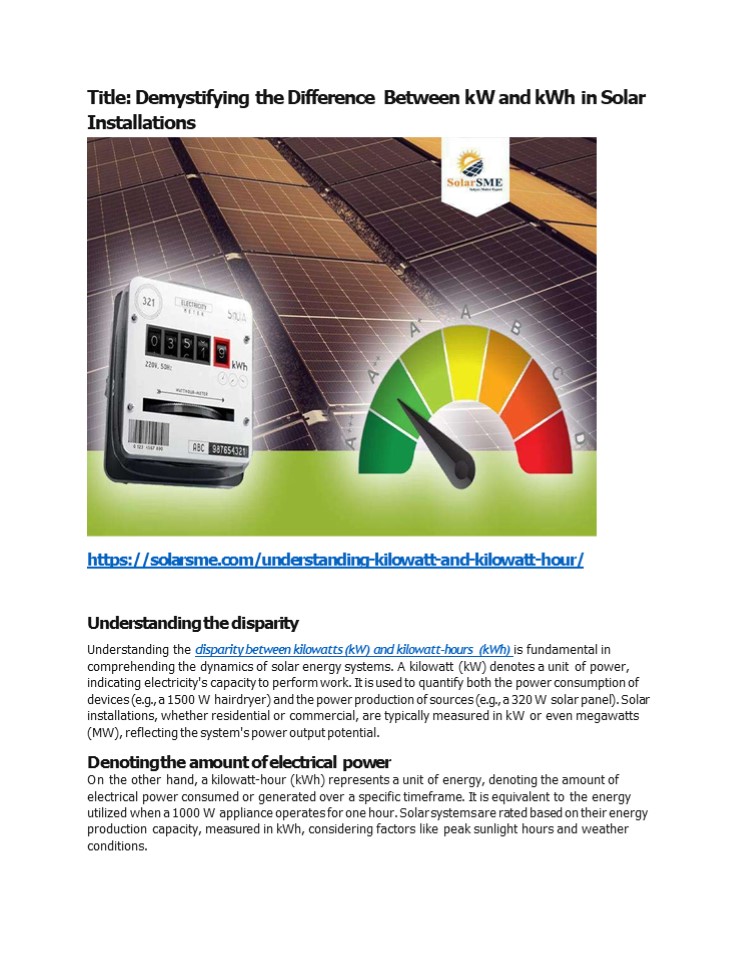Demystifying the Difference Between kW and kWh in Solar Installations - PowerPoint PPT Presentation
Title:
Demystifying the Difference Between kW and kWh in Solar Installations
Description:
Understanding the distinction between kW and kWh is crucial in grasping solar energy systems. A kilowatt (kW) represents power, indicating electricity's capacity for work, used to measure both consumption and production. Solar installations are typically measured in kW, reflecting their power output potential. Conversely, a kilowatt-hour (kWh) denotes energy, representing the amount of electrical power consumed or generated over time. Solar systems are rated in kWh, reflecting their energy production capacity. Both kW and kWh are integral in planning solar installations, aiding in determining system size based on energy consumption, available space for panels, and potential energy production. – PowerPoint PPT presentation
Number of Views:0
Title: Demystifying the Difference Between kW and kWh in Solar Installations
1
Title Demystifying the Difference Between kW and
kWh in Solar Installations
https//solarsme.com/understanding-kilowatt-and-ki
lowatt-hour/
Understanding the disparity Understanding the
disparity between kilowatts (kW) and
kilowatt-hours (kWh) is fundamental in
comprehending the dynamics of solar energy
systems. A kilowatt (kW) denotes a unit of power,
indicating electricity's capacity to perform
work. It is used to quantify both the power
consumption of devices (e.g., a 1500 W
hairdryer) and the power production of sources
(e.g., a 320 W solar panel). Solar
installations, whether residential or commercial,
are typically measured in kW or even megawatts
(MW), reflecting the system's power output
potential. Denoting the amount of electrical
power On the other hand, a kilowatt-hour (kWh)
represents a unit of energy, denoting the amount
of electrical power consumed or generated over a
specific timeframe. It is equivalent to the
energy utilized when a 1000 W appliance operates
for one hour. Solar systems are rated based on
their energy production capacity, measured in
kWh, considering factors like peak sunlight hours
and weather conditions.
2
Conclusion Both kW and kWh play pivotal roles in
planning solar installations. Understanding
energy consumption patterns helps determine the
appropriate system size required to offset grid
reliance. Additionally, assessing available roof
or ground space aids in estimating the potential
kW capacity of the solar array. While kW
indicates system size, kWh provides insights into
energy production potential, essential for
optimizing solar system efficiency and
performance. BOOKMARKING Understanding the
distinction between kW and kWh is crucial in
grasping solar energy systems. A kilowatt (kW)
represents power, indicating electricity's
capacity for work, used to measure both
consumption and production. Solar installations
are typically measured in kW, reflecting their
power output potential. Conversely, a
kilowatt-hour (kWh) denotes energy, representing
the amount of electrical power consumed or
generated over time. Solar systems are rated in
kWh, reflecting their energy production
capacity. Both kW and kWh are integral in
planning solar installations, aiding in
determining system size based on energy
consumption, available space for panels, and
potential energy production. FOR
CLASSIFIED Understanding the distinction between
kilowatts (kW) and kilowatt-hours (kWh) is vital
for effectively navigating solar energy systems.
Kilowatts measure power, representing
electricity's work capacity for both consumption
and production in solar installations. They
quantify the system's power output potential,
crucial for determining the size and efficiency
of the solar array. On the other hand, kilowatt-
hours quantify energy, denoting the amount of
electrical power consumed or generated over time.
This measurement is pivotal in assessing the
system's energy production capacity and
optimizing its performance. By comprehending
both kW and kWh, businesses can strategically
plan their solar installations, ensuring they
meet energy consumption needs while maximizing
efficiency and cost- effectiveness. Ultimately,
leveraging this knowledge empowers businesses to
harness solar energy effectively, reducing
reliance on the grid and driving sustainable
practices.































